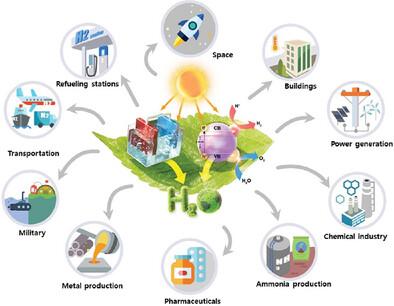A Roadmap of Sustainable Hydrogen Production and Storage: Innovations and Challenges
IF 13
2区 材料科学
Q1 CHEMISTRY, MULTIDISCIPLINARY
引用次数: 0
Abstract
The present review offers a strategic roadmap for overcoming conventional photocatalyst limitations and emphasizes recent advancements in hybrid photocatalysts, thereby addressing electrode and topology-associated challenges for sustainable hydrogen (H₂) production and storage. Unlike traditional reviews, this paper explores the latest developments in hybrid photocatalysts and provides a thorough analysis of H₂ fuel technology, including water splitting, photocatalytic reactions, and storage issues. A detailed analysis of photoelectrochemical (PEC) water splitting, which mimics photosynthesis, to produce carbon-neutral H₂ and the importance of optimizing PEC devices with co-catalysts are highlighted. Advanced photocatalyst designs, including Z-scheme and S-scheme heterojunctions, doping, surface modifications, and copolymerization, are discussed and the impact of various materials, such as conjugated microporous polymers (CMPs), covalent organic frameworks (COFs), graphdiyne, MBene, TiO₂-based compounds, metal sulfides, and group III–V compounds, on PEC activity is examined. Furthermore, this review highlights strategies for improving photocatalyst performance, such as targeted doping, vacancy creation, and hybrid composite formation. Recommendations include designing cost-effective efficient hybrid photoelectrodes, maximizing light utilization, and simplifying PEC cell design. By addressing H₂ storage, transport, and conversion challenges, this review not only covers critical aspects of H₂ production but also provides a roadmap towards achieving a sustainable hydrogen future.

求助全文
约1分钟内获得全文
求助全文
来源期刊

Small
工程技术-材料科学:综合
CiteScore
17.70
自引率
3.80%
发文量
1830
审稿时长
2.1 months
期刊介绍:
Small serves as an exceptional platform for both experimental and theoretical studies in fundamental and applied interdisciplinary research at the nano- and microscale. The journal offers a compelling mix of peer-reviewed Research Articles, Reviews, Perspectives, and Comments.
With a remarkable 2022 Journal Impact Factor of 13.3 (Journal Citation Reports from Clarivate Analytics, 2023), Small remains among the top multidisciplinary journals, covering a wide range of topics at the interface of materials science, chemistry, physics, engineering, medicine, and biology.
Small's readership includes biochemists, biologists, biomedical scientists, chemists, engineers, information technologists, materials scientists, physicists, and theoreticians alike.
 求助内容:
求助内容: 应助结果提醒方式:
应助结果提醒方式:


